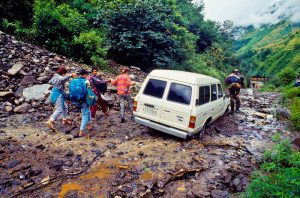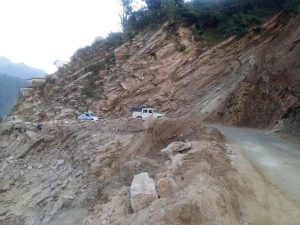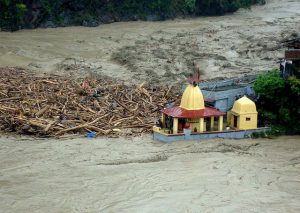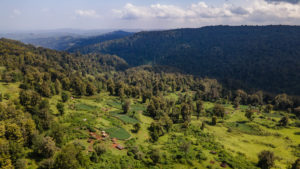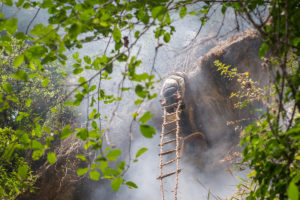A week after a flash flood swept away pilgrims and their tents near the Hindu pilgrimage site of Amarnath at the western end of the Indian Himalayas, at least 40 people are still missing, while 16 deaths have been confirmed. Around 15,000 people had to be rescued after the disaster on 8 July. The pilgrimage resumed on the fourth day following the tragedy.
At the eastern end of the Indian Himalayas, at least 52 people were killed in a landslide on 30 June near a railway line being built to Imphal, the capital of Manipur. The line has been described by the railway ministry as its most ambitious: it involves digging 46 tunnels under the mountains, including one that is 11.55 km long, slated to become the longest in India. A substantial piece by The Hindu revealed that the Manipur Public Works Department had warned against siting the line along unstable hillsides. Railway officials have chosen to blame the disaster on slash-and-burn cultivation, while independent observers told The Hindu that railway engineers undercut the hillside to a dangerous degree.
Repeated warnings are being ignored, from pilgrimages to the construction of rail lines, roads, dams and other infrastructure projects
As the fragility of the Himalayas increases with the impacts of climate change, repeated warnings are being ignored, from pilgrimages to the construction of rail lines, roads, dams and other infrastructure projects.
The widening of roads leading to four Hindu shrines in Uttarakhand – Kedarnath, Badrinath, Gangotri and Yamunotri – is a case in point. Environmentalists went to court to prevent the work. The Supreme Court set up a committee of experts. In 2020, Ravi Chopra, chair of the committee, recommended against the widening, as The Third Pole reported. The government went back to the Supreme Court to say that the army needed wide roads to move armament to the India-China border. The court then allowed the widening. The number of pilgrims on those routes – the same routes that were hit in 2013 – is many times the number of soldiers using them or heavy armaments being moved.
Amarnath: A disaster foretold
The Amarnath pilgrimage is an annual affair with repeated disasters, now made more likely by climate change. In the disaster last week, tents for pilgrims had been set up on the floodplains of Panchtarni, a confluence of five rivulets below the final ascent to the 3,880-metre-high cave shrine. The flash flood was the result of heavy rain upstream in one of the rivulets.
The extreme risk of setting up tents in floodplains was made clear by the Kedarnath flash flood in June 2013 in the central Himalayas, when at least 800 people were killed in Uttarakhand and millions affected. In that case too, tents and buses on the floodplains were swept away in a glacial lake outburst flood.
In 2021, there was another flash flood near the Amarnath shrine. There were no casualties because the pilgrimage had been suspended due to the Covid-19 pandemic.
As this year’s pilgrimage was being planned, disaster management experts speaking to each other in personal exchanges over social media, seen by The Third Pole, warned the authorities against putting tents in the floodplains. The authorities responded that there was no other space in the steep hilly area. The compromise was to site the tents as far away from the riverbed as possible and to build a two-foot-high stone wall to keep the water away in case of a flash flood. When the flood came, both measures proved inadequate. The authorities now say they did not put the tents in the floodplains, despite video evidence from pilgrims to the contrary.

Too many pilgrims despite recommended limit
One point on which the authorities are correct is that there is no space to house around 15,000 pilgrims at a time except on the floodplains. But there should not be so many pilgrims near the shrine at all. After a disaster in the area in 1996, the Indian government set up a commission to recommend how to avert a repeat. The commission, chaired by bureaucrat Nitish Sengupta, said there should be no more than 3,000-3,500 people in or around the shrine in a day.
None of these lessons have been learnt. The India Meteorological Department is now being blamed for not forecasting the heavy rainfall and the consequent flash flood despite having a dedicated website for the pilgrimage. But experts speaking to authorities in private social media group exchanges pointed out that science to forecast sudden rainfall in mountain areas does not exist yet.
There will be damage when there are flash floods. But authorities have heightened the risks by paving much of the route to the Amarnath cave, which prevents water from seeping underground. The chances of flooding with even moderate rainfall have increased.
Even now, no lessons learnt
Disaster management experts have reiterated some safety precautions for the Amarnath pilgrimage after last week’s disaster, starting with siting of tents on high ground; no pilgrim inside the cave shrine after 3 pm so that people can get to safer places by daylight; a risk assessment every 30 minutes; proper earmarking of emergency routes; and most importantly renewed assessment of the number of pilgrims that should be allowed in the area in a day.
But there is no indication that the authorities are listening, even now. There is no move to restrict the number of pilgrims.
Science to forecast sudden rainfall in mountain areas does not exist yet
And it is not just the authorities. It becomes very difficult to plan safety measures in the face of fatalism by most pilgrims. This year, for the first time, every pilgrim was given a radio frequency identification device (RFID). Everyone was told to wear this around their neck. But far too many pilgrims kept the device in handbags or pockets. When rescue teams used RFID locators to search for people buried under rubble after the flash flood, they kept finding the devices far from the victims. Many more lives may have been saved if all pilgrims had kept the devices around their necks.
As climate change increases the likelihood of such disasters, both the authorities and individuals need to better heed the advice and preventative measures that are available.


